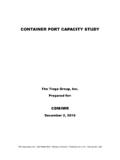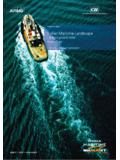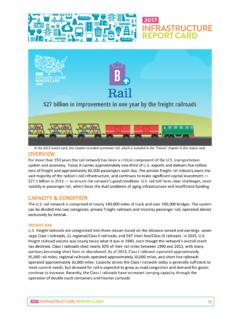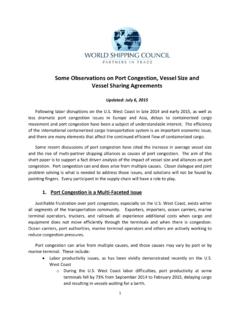Transcription of A Look at Container Ports Available to North Carolina ...
1 A Look at Container Ports Available to North Carolina Exporters and ImportersJanuary 3, 2011 Prepared for Save the Cape, AssociatesSouthport, North CarolinaOld Saybrook, and Traffic and and Traffic and and Traffic and and Traffic and Ports Compared Capacity and and to Serve Ports Compared Operating Container Traffic in North Effects of Demand for Deep AssociatesSave the Cape, Look at Container PortsAvailable to North Carolina Exporters and ImportersFind a need and fill it Henry J. Kaiser(Also attributed to Ruth Stafford Peale)SummaryThe Governor has created a Logistics Task Force to make recommendations fordevelopment of an integrated logistics plan for North Carolina .
2 The first step is a properdefinition of the problem an inventory and evaluation of existing transportation assets,including Ports , airports, highways, railroads, and major distribution centers and business andindustrial parks. Any review of Ports Available to North Carolina businesses must look outside of theState as well as in. Shippers and importers are indifferent to state borders. Indeed, four-fifthsof North Carolina s international commerce moves through Ports in other States. The marketdetermines which Ports are closest, offer the lowest costs, and provides the most advantageousservice. State loyalty is reserved to the Tar Heels and the current inquiry into Ports Available to North Carolina businesses must also considerthe plan of the North Carolina State Ports Authority for a massive new marine containerterminal.
3 The new port, to be located on the Cape Fear River downstream from the State Portat Wilmington, has been conceived to compete on even terms with the largest Ports in the report examines the need for Container terminal facilities, to provide a context forconsideration of that project or any other to serve North Carolina . We look at containerterminals in Virginia, South Carolina , and Georgia, as well as the State Port at Wilmington. We look at regional port capacity, relative to anticipated need. We look at land-sideinfrastructure roads and we look at results. What does the market say? Where does the market choose tosend its exports and obtain its imports?
4 What Container port facilities would North Carolinabusinesses need in the coming decades? Where should they be?We find that North Carolina is, and will be, well-served by the small Container terminalat Wilmington and the larger terminals in Virginia, South Carolina , and Georgia. All havesubstantial excess capacity, and with expansion projects underway or in advanced stages ofplanning, will have adequate capacity for the foreseeable future. These Ports have overlappingservice areas that cover the State of North Carolina and provide a competitive environment. Risingwater Associates2 Save the Cape, Executive Order Number 32 on December 8, 2009, Governor Perdue establishedthe Governor s Logistics Task Force to make recommendations to create an integrated logisticsplan for North Carolina .
5 The mandate is very broad, and includes a thorough inventory andevaluation of existing public and private transportation and commerce assets, including Ports ,airports, highways, railroads, major distribution centers, and business and industrial parks, and then to project future needs and make recommendations to create an integrated logisticsplan for North Carolina . The North Carolina State Ports Authority operates two Ports : the Port of Wilmington,with facilities for bulk and break-bulk cargoes and containerized freight, and the Port ofMorehead City, with facilities for bulk and break-bulk cargoes but without special cranes andother equipment for containerized State Ports Authority has also purchased, for $30 million, a 600-acre undevelopedsite on a tributary of the Cape Fear River near Southport about 20 miles downstream from thePort of Wilmington, and has invested $6 million in preliminary engineering for a newcontainer terminal.
6 The proposed terminal, to be called the North Carolina InternationalTerminal, would be larger than any on the east coast of the United States except the combinedterminals at Port Elizabeth and Port Newark, New Jersey. Planned capacity is 3,000,000twenty-foot equivalent units (TEU) per year. The project would include dredging a channelsufficient for deep-draft Container ships of the size able to pass through the Panama Canal onlyafter larger locks and other improvements are completed sometime after of imports and exports throughports disregard state boundaries. North Carolina isserved by several Ports in other states, which arelarger and busier than the Ports in North Carolina , dueto proximity to large markets.
7 Four Ports at HamptonRoads in Virginia, three Ports in Charleston Harbor,and a large Container terminal on the Savannah Riverabove Savannah serve North Carolina businesses. These out-of-state Ports are closer by road to manyareas of North Carolina in which industry isconcentrated than are the Ports operated by the NorthCarolina State Ports Authority. The presence of theseports creates a competitive environment whichprovides a range of shipping opportunities. NorthCarolina businesses can make a shipping decisionconsidering availability of service, distance, cost,time, and scheduling convenience. Risingwater Associates3 Save the Cape, charts show the Ports used for North Carolina imports and exports ofcontainerized freight: Ports in Virginia and South Carolina each handle more of North Carolina s containermovements than North Carolina s own port at Wilmington.
8 This is what the market chooses,in an environment of many an inventory of facilities Available for North Carolina imports and exports must ofnecessity include the Ports in neighboring states the capacity, the land-side infrastructure, theadequacy of those facilities today and in the issue is complicated by the impending expansion of the Panama Canal, the route ofchoice for trade with eastern Asian Ports . The locks now in use are about 40 feet deep and 110feet wide. The maximum size Container ship (called Panamax ) able to transit the canal cancarry slightly more than 4000 TEU. All Container terminals on the East Coast (exceptRichmond) have channels maintained at 42-foot depth, sufficient for such vessels.
9 However, athird set of locks parallel to the existing locks at the Panama Canal, now under construction,will be 50 feet deep and 180 feet wide, and much larger Container ships (called post-Panamax or new Panamax ) would be able to use the canal to reach US East Coast portsfrom Asia. But access may be limited by channel depth. Of Ports in the Southeast, onlyHampton Roads in Virginia is 50 feet deep; others have depths ranging from 42 to 45 feet. When the additional dimension of time is considered, plans now in progress for increasedchannel depths must be taken into account in an inventory of Ports serving North Associates4 Save the Cape, Inc.
10 Development of a logistics plan for North Carolina is like any other problem,mathematical or scientific or economic: it must be addressed first by a comprehensivestatement of the problem. Often, such a statement suggests the solution, and it wouldcertainly suggest a range of alternatives for report attempts to provide an inventory, to define the problem, if indeed there isone. We concentrate on containerized freight, the largest and fastest-growing segment of theshipping spectrum and the segment getting the most attention from various state portauthorities in planning for growth. We examine the characteristics of the marine containerterminals in North Carolina and neighboring states the capacity, the infrastructureconnections, the market, the ability to accommodate growth.







